History of Photography
1839 and the Frenzy that Followed
In our last article, we covered the invention of photography up until 1839 when Argo announced Daguerre’s invention and spoke of his accomplishment to the French Academy of Sciences. By the middle of January, news of Daguerre’s invention had spread around the world. The actual techniques used remained secret, however, as the French government had not yet officially agreed to buy the invention from Daguerre, but the fact that photographs had been made and exhibited caused a frenzy everywhere.
The Chaos Begins in England
William Henry Fox Talbot, he of too many names and too many interests (he had set aside his development of photography to work on an archeology book), took the news rather badly. He reaction was immediate and overblown — which would characterize most of his reactions over the next 15 years. Talbot was an intelligent man, but he was stubborn to a fault and perhaps a bit insecure. He was quite afraid that he would not receive public credit or financial gain for his work on photography and his actions would make that a self-fulfilling prophecy.
The announcement of Daguerre’s achievement came on January 6 or 7, 1839 and wasn’t published in England until January 19th. When Talbot read of it, he later wrote (in typical dramatic fashion) that he was “placed in an unusual dilemma, scarcely to be paralleled in the annals of Science”. Having no idea if Daguerre’s methods differed from his own, he immediately tried to establish precedence as the inventor of making permanent images using the camera obscura (the only thing he knew Daguerre used). He rushed samples of his “photogenic drawings” to the Royal Institute in London where they were exhibited on January 25th, only weeks after Daguerre’s announcement. In an effort to establish precedence he documented that they had been taken as early as 1835.
He wrote letters to Argo and other academicians stating that he would file disputes regarding the priority of Daguerre and presented a paper with the catchy title of “Some Account of the Art of Photogenic Drawing, or, the Process by which Natural Objects May Be Made to Delineate Themselves without the Aid of the Artist’s Pencil”. When he learned that Daguerre’s images were positives made on silver plates he began filing patents for images made on paper and made using negatives.
Sir John Hershel, an acquaintance of Talbot’s and a superb scientist, also had read of Daguerre’s achievements and saw Talbot’s work and presentations at the Royal Institute. Having no dog in this fight, and perhaps because he was a much better scientist, Hershel simply sat down in January of 1839 and wrote in his journal:
Experiments tried since hearing of Daguerre’s secret and that Fox Talbot has something of the same kind. Obviously three requisites:
- Very susceptible paper
- Very perfect camera
- Better means of arresting the further actions of light.
Being an excellent chemist, within a few days he had sensitized paper with silver salts and made images — in fact he was exhibiting photographs he had made by February. He was aware that both Daguerre and Talbot could not permanently fix their images, that is, the images very slowly deteriorated over time with exposure to light. But he knew from experiments he’d done in 1819 that hyposulphite of soda (sodium thiosulfate) dissolved silver salts. He used this to fix his images permanently noting simply “Thus Daguerre’s problem is solved”. Not only did Daguerre and Talbot adapt “hypo” (as it has since been known to photographers) as their fixative, but it became the primary fixative used almost to this day.
Hershel also found Talbot’s term “photogenic drawing” rather cumbersome and coined the term “photography”. Likewise he found Talbot’s terms “reversed copy” and “re-reversed copy” rather silly and was the first to use the terms Negative and Positive to describe the images. Hershel also experimented with non-silver chemicals in an attempt to make the process less expensive. He found he could create a light sensitive process using iron citrate and potassium ferricyanide which resulted in bright blue images: the Cyanotype. While it never became popular for photography, it did become the photocopier of the 1800s: the blueprint.
Noticing the furor over in England, Argo invited Hershel, Talbot and other English scientists to come to Paris to view Daguerre’s work. Talbot apparently was too busy filing patents and refining his technique, but Hershel went. Much to Talbot’s dismay, Hershel wrote publicly:
. . . compared to these masterpieces of Daguerre, Monsieur Talbot produces nothing but vague, foggy things. There is as much difference between these two products as there is between the moon and the sun.
Probably not realizing that Talbot was taking all this personally, rather than scientifically, Hershel wrote to Talbot in a letter:
It is hardly too much to call them miraculous. . . . every gradation of light and shade is given with a softness and fidelity which sets all painting at an immeasurable distance. His [exposure] times are also very short. In a bright day three minutes suffice.
There is no question Hershel’s description was accurate. The difference between a Daguerrotype (top image below) and Talbot’s images (second image below) is dramatic.
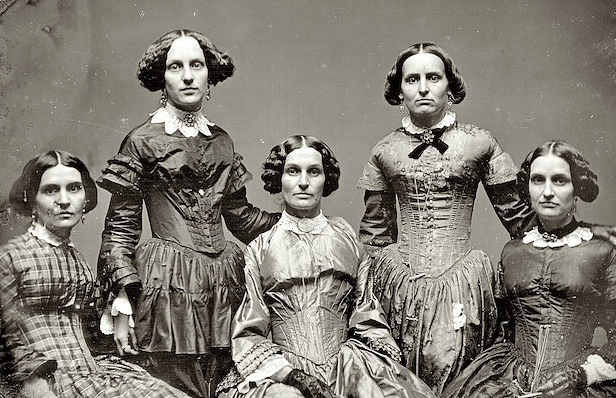
Daguerrotype of the Clark Sisters. If they are all single, one would assume from their expressions they will remain that way forever. More likely, they are all married and their expressions reflect that divorce was not really an option in those days. Thankfully it is nowadays - my ex-wife used to have the same expression as the second one from the right.
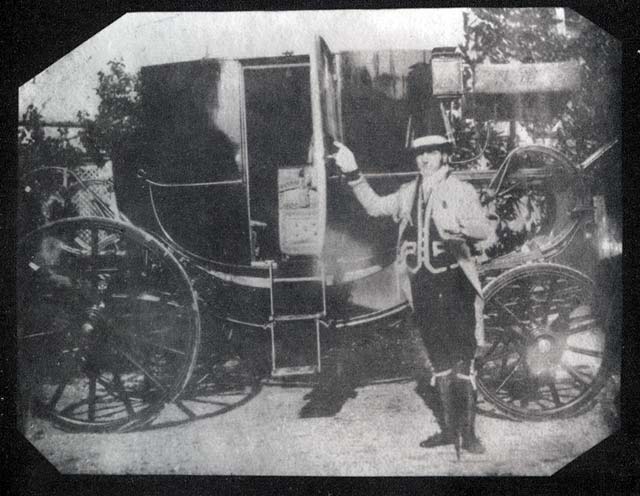
An image Talbot made of his Coachman. The exposure times of the day meant he had to hold this position for several minutes. That's a good Coachman, although not a very good photograph.
Talbot, who initially required 30 minutes, at least, to expose an image, must have tossed his breakfast after reading that. But Talbot was a stubborn man and just continued to insist his way was the right way. It was, of course, but because Talbot just couldn’t get out of his own way, it would be years before that became apparent.
Daguerre’s Triumph
At this point, May of 1839, Daguerre was still waiting for the French Government to actually pay for his invention. Argo wanted to make it “a gift to the world” but Daguerre wasn’t that altruistic. He hadn’t been waiting idly, however. He’d taken a rather broad interpretation of Argo’s definition of the world and decided that meant France. So he quietly had an agent take out patents on his invention in England.
Daguerre also quietly arranged for his brother-in-law, Alphonse Giroux, to produce a solid wooden camera with lens supplied by Chevalier and a complete set of chemicals for his process. Each bore on its side a metal label stating “No apparatus is guaranteed unless it bears the signature of M. Daguerre and the seal of M. Giroux”. Giroux and Daguerre already were mass-producing these before the official announcement of his process was made, knowing there would be a huge demand and no one else would have anything readily available.
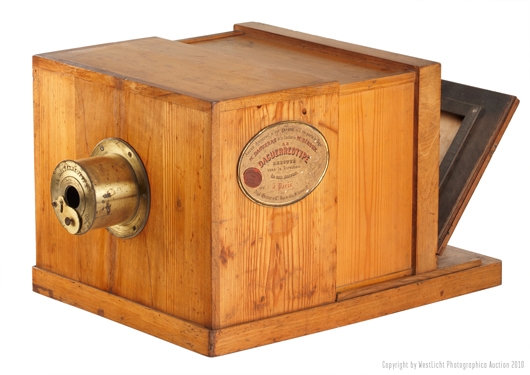
An original Giroux camera. If you find one at a garage sale, grab it. You hardly ever see one on eBay. They sell for about $1 million in reasonable condition.
On July 19th, the French Government finally passed a bill giving Daguerre a lifetime pension in return for his process (and a smaller one for Isidore Niepce). On August 19th, 1839 the details of the process were made public at a joint meeting of the French Academies of Science and Fine Arts. The event generated more excitement than a Hannah Montana concert at Disneyland: people arrived three hours early to find the hall already full and crowds lining the street. Within days every optician and chemist in Paris (and elsewhere for that matter) had sold out of lenses, silver nitrate, silver plates, and everything else needed to create photographs.
Daguerre retired almost immediately to Bryn-Sur-Marne where he wrote a 79 page booklet on his process that was immediately translated into a dozen languages. He continued quiet experimentation in photography and actually is credited with developing the first shutter, allowing photographers to limit the amount of light entering the camera.
The effects of the release were huge. Photographers were soon swarming over every bit of photographable real estate in Paris, making image after image (real estate because the early Daguerrotypes required exposure times too long for portraits). Just like today, many were making artistic images, but others quickly became more enamored with the equipment’s resolution. A lament written at the time would sound perfectly in place today.
Our young men should spend more time considering the composition and merit of their images, and less time with magnifying glasses counting how many bricks and shingles they can resolve.
The exposure times shortened quickly as chemical processes were refined, however, and professional portraits were now made by photographers, rather than painters. Within a year Daguerrists, as the were called, had set up studios in every major city of the world. Well, except in England. Daguerre’s patent sort of prevented that for a while, although there were workarounds. Even smaller cities had traveling Daguerrotypists and, for the first time an image of a family member could be made and then kept forever.
Hippolyte, Hercules, and Sam
If you remember from the last article, two members of the “greatest names in photography” team, Antoine Hercules Florence and Hippolyte Bayard had also developed photographic techniques at this time. Hercules, a Frenchman living in Brazil, would only have distant knowledge of the events in Paris at this time. When he did become aware, though, he was the perfect gentleman stating only that his techniques were not nearly as advanced as those of Daguerre and making no claims for himself.
Hippolyte Bayard had approached M. Argo in early 1839, presenting his own techniques which created positive images, like Daguerrotypes, but used less expensive paper, like Talbot’s process. Argo, fearing the claims of Bayard would interfere with his plan to release the Daguerrotype process “as a gift to the world”, asked Bayard to remain quite and inferred that he, too, would get some form of government pension. This didn’t happen and Bayard ended up demonstrating his technique to the French Institute in exchange for enough money to buy some new equipment.
Bayard, who loved him some drama, used his technique to create the first staged photograph: “Self Portrait As a Drowned Man” which he exhibited at the French Institute with the following caption:
The corpse which you see here is that of M. Bayard, inventor of the process that has just been shown to you. As far as I know this indefatigable experimenter has been occupied for about three years with his discovery. The Government which has been only too generous to Monsieur Daguerre, has said it can do nothing for Monsieur Bayard, and the poor wretch has drowned himself. Oh the vagaries of human life….! … He has been at the morgue for several days, and no-one has recognized or claimed him.
Hippolyte got his stuff together after a bit, though, and went on to have a most successful photographic career. Shooting Daguerrotypes.
As an aside, the U. S. was among the first countries to embrace the Daguerrotype. Samuel Morse, the inventor of the telegraph and Morse Code, was actually first and foremost a painter. He was in France negotiating patents for his invention in 1839 and was present during Daguerromania, which he caught. He met Daguerre and learned the technique from him and obtained a camera and supplies.
Surprisingly, when Morse returned to America he was broke: the U. S. government hadn’t paid him for inventing the telegraph and his patents were tied up in court. He supported himself by opening one of the first photographic studios in the U. S. and later by teaching photography to students for $25 each. In three years he taught most of the great early American photographers: Matthew Brady, Edward Anthony, Albert Southworth, and Samuel Broadbent. In 1843, the government finally paid him for the invention of the telegraph and he retired, but he truly is the father of American Photography.
Talbot Continues the Chaos
Back in England Talbot continued to work on his process and actually made great strides and a great discovery: the principle of developing a latent image. He found that if he bathed his silver iodide papers in a solution of gallic acid and silver nitrate after a brief exposure, the latent image (invisible at first) would “develop” and become visible. He then “fixed” his negatives in hypo and printed positives as he always had. This had the supreme advantage of shortening exposure times dramatically.
It is this process, the Calotype, that became the forerunner of all film photography. The Calotype images were markedly improved over Talbots early work, although they still didn’t provide the shockingly superb detail of a Daguerrotype. But it had one huge advantage: because it made a negative, hundreds, even thousands of positive prints could be made from one photograph. A Daguerrotype was a single image that was not printable. Only the Calotype had the potential to provide mass media.
Talbot, either because he felt he deserved to profit as others had, or because Daguerre still retained a patent for his process in England, patented his invention and charged such high fees that almost no one bothered using the process. However, a group of opticians, chemists, and photographers who wished to use the process began a long series of legal battles attempting to overturn Tablot’s patents. The more they tried, the more stubborn he became and the battles raged on for a decade.
There was one escape, though: Talbot, being quite the Anglophile, had patented his process in England, Wales and France, but didn’t bother to patent it in Scotland and other countries. It is for this reason, more than any other, that Scotland in the 1840s became a center of photography. Scottish photographers could use the Calotype or the Daguerrotype without paying any patent royalties; photographers in England had to pay royalties for either process. The best early examples of Calotypes we have are those of Scottish photographers David Hill and Robert Adamson.
As for Talbot himself, he made hundreds of Calotypes and published them in a series of books entitled “The Pencil of Nature”. Talbot’s energy was focused upon fiercely enforcing his patents in England, paying little heed to other countries. A number of French photographers realized this and began using his process with impunity.
It probably didn’t help Talbot’s mood much that Frenchmen made two dramatic improvements to his technique. The first, waxing the paper used in the process, increased the detail available in the photographs significantly. The second, the use of the albumen process to print positives from negatives reduced the printing time so much that literally thousands of prints a day could be made from a single photograph (Talbot’s technique allowed for, at most, a few hundred). Despite Talbot’s patent enforcement attempts, Calotypes became THE method used by explorers, archeologists, and others publishing their photographs or documenting their travels in book form. For a little while.
The Real Father of Photography?
Talbot vigorously defended his English patents for a decade, until Frederick Scott Archer published a new technique, the collodion or wet plate process, that used glass coated with a gelatin to hold the silver chemicals. Unlike Talbot, Archer did not patent the process, but published his techniques so that others could use it freely. Talbot attempted to sue wet-plate photographers on the grounds that this technique was just like his own. British photographers and opticians, long fed up with Talbot’s restrictive patents, rallied to the case and brought reams of evidence that Talbot was not the true inventor (much of the evidence was later found to be false). The jury, in one of those moments of legal technicality, found that Talbot’s patents were valid, but only for his exact process and anyone who varied from his published methods even slightly was not guilty of patent violation.
Talbot had finally lost the war, and England had finally joined the rest of the world in taking photographs. More importantly, since Talbot’s patents were now basically unenforceable, the obvious advantages of making multiple prints from negatives led to a focus on that type of photography. Archer’s wet plate technique itself advanced photography greatly, and the fact that it led to the breaking of Talbot’s patents particularly advanced the art in England.
Frederick Scott Archer, unfortunately, benefitted not at all. He died penniless in 1857. After his death, Punch magazine wrote, asking for donations for the family:
The inventor of Collodion has died, leaving his invention, unpatented, to enrich thousands, and his family unapportioned to the battle of life. Now, one expects a photographer to be almost as sensitive as the Collodion to which Mr. Scott Archer helped him. . . . you, photographers, set up Gratitude in your little glass temples of the sun, and sacrifice, according to your means, in memory of the benefactor . . . answers must not be Negatives.
About 767 pounds were raised. A fair amount of money at the time. Almost as much as Talbot wished to charge for one license to distribute the Calotype process.
The Collodion process wasn’t perfect. Collodion (nitrocellulose), which is made from gun cotton dissolved in ether and alcohol, has an annoying tendency to explode violently. Preparation of the plates and photographic technique using them was difficult. But the images obtained were better than Calotypes and were negatives that could print thousands of copies, unlike Daguerrotypes. Direct positive images would continue to be made, not only Daguerrotypes, but less expensive Tintypes and Other types. But the negative-image-to-positive print process would become the standard well before the turn of the century. Particularly when Eastman discovered a method for drying the collodion on plates (dry plate photography) and later plasticizing it to create film (celluloid).
So who was the real Father of Photography? It would make a good paternity suite. Niepce created the first permanent images using a camera. Daguerre perfected the technique that allowed it to become mainstream (and was the only one to benefit financially). Talbot’s different technique was the only one that would allow multiple copies of images to be mass produced, and the negative-image to positive-print is the basis for all photography from the 1800s until digital.
But I think no matter who you credit with fathering photography, Frederick Scott Archer, who freed photography so that anyone of reasonable means could afford to take photographs and whose discoveries led directly to the development of film, is the one who raised the child.
Roger Cicala
Lensrentals.com
May 2011
Resources:
Bankston, John: Louis Daguerre and the Daugerrotype. Mitchell Lane. Delaware.
Gustavson, Todd: A History of Photography from Daguerrotype to Digital. Sterling, 2009.
http://niepce.house.museum/pagus/invus4.html
http://www.rleggat.com/photohistory/history/cameraob.htm
Marien, Mary W: Photography. A Cultural History. 3rd ed. Prentice Hall. 2011
Newhall, Beaumont: The History of Photography. Museum of Modern Art, New York. 2009
Osterman, Mark and Romer, Grant: History of the Evolution of Photography. In: Peres, Michael (Ed.): The Focal Encyclopedia of Photography, 4th, ed. Elsevier, 2007.
Osterman, Mark. 2007. Asphalt. In The Focal Encyclopedia of Photography: Digital Imaging, Theory and Applications, History, and Science, ed. Michael R. Peres, 44, Focal Press.
“Samuel Morse: Father of American Photography”
Tims, John and Elmes, James: The Diorama in Great Britain in the 1820s, History of Photography, Autumn 1993, Vol.17 (3), pp. 284-295
Zakia, Richard: The Focal Encyclopedia of Photography. 3rd ed. Butterworth-Heinemann, 1993.
Author: Roger Cicala
I’m Roger and I am the founder of Lensrentals.com. Hailed as one of the optic nerds here, I enjoy shooting collimated light through 30X microscope objectives in my spare time. When I do take real pictures I like using something different: a Medium format, or Pentax K1, or a Sony RX1R.
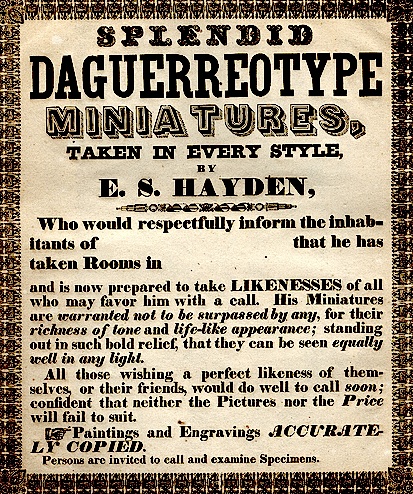
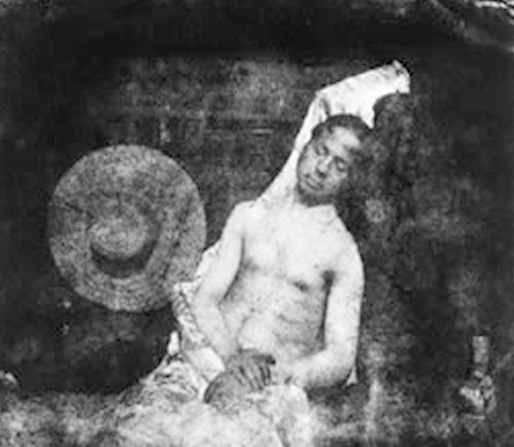

Pingback: LensRentals.com - Lens Geneology Part 1()